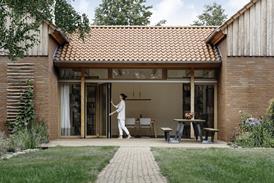Kate Freeman explains what happens when a landlord becomes an electricity supplier
One way to help tenants use less energy and reduce their fuel bills is to install a combined heat and power community heating system. This is essentially an engine that burns fuel to generate electricity, but simultaneously captures the heat this produces to warm water that can be piped to the central heating systems of nearby buildings.
Because electricity is generated on site, less is lost in transmission than would be if it came from a power station. This, combined with the capture of heat, means CHP typically uses 35% less energy than power stations and heat-only boilers. It can reduce carbon dioxide emissions by up to 50% compared with coal-fired power stations.
The government is pushing for CHP systems to be used more and the Department for the Environment, Food and Rural Affairs has £50m to distribute to such projects between 2002 and 2005.
If you’re considering a community CHP system, you should start with a feasibility study, says John Bird, assistant director of asset management at St Pancras & Humanist Housing Association. St Pancras installed a system for 56 flats and its offices in 1995. It employed a engineer to do initial calculations, which took nine weeks.
CHP systems are only feasible where the homes to be heated are close together, so hot water pipes can be directly attached.
You will also need room for the CHP system as they are quite large: St Pancras’ system, which heats 95 flats, a community centre, office and 10 shops, is 3m long x 2m high x 1m deep.
When St Pancras installed its system, Bird’s staff did a lot of door knocking and held meetings to convince people to make their landlord their electricity supplier. “Telling them they’d save 10% on electricity bills was a big hook,” he says, adding that tenants saved closer to 25% because the system was more efficient than expected.
To reduce confusion, St Pancras made sure its electricity bills looked similar to residents’ previous, quarterly, bills. They simply removed the standing charge and kept the tariff per electrical unit the same, rather than deducting a percentage from both standing charge and tariff, which residents said they’d find confusing.
Meters
Telling tenants they'd save 10% on electricity bills was a big hook. In fact, they saved 25%
Perthshire Housing Association, which installed a system jointly with Servite Housing Association in Scotland in 1999, took a different approach. Chief executive John Kernahan points out quarterly bills are not always easy for tenants on low incomes.
“We decided to put in card meters for electricity because we were worried tenants could get into fuel debt, which would leave us looking to disconnect people for non-payment, which would be unacceptable to our board,” he says.
The charge for the heating itself is usually kept separate and most associations use a fixed service charge proportionate to the size of the flat. Because people don’t pay for the amount of fuel used, this means they can always have warm homes and there is less danger of people switching the heating off to save money – a worry for vulnerable elderly tenants.
Installing a CHP system is expensive: Perthshire spent about £2500 per unit. About 55% of this came from DEFRA, the rest from the association. But grants are also available from the Energy Saving Trust and funding for CHP should now be even more accessible through the government’s Community Energy programme.
One word of warning: some CHP systems need to be serviced more frequently than a normal boiler – about once a month rather than once a year. Kernahan admits: “I don’t think we quite realised what the maintenance implications were.”
But because the fuel costs so little, this expense will still be covered by the standing charge for the heating, he adds. John Bird recommends outsourcing maintenance of the machinery because of the specialist skills and knowledge needed.
If you generate more electricity than you need, you may make a profit. St Pancras sells electricity to several shops that rent space in its buildings. The retailers save 10% on their electricity bills – rather than the 25% saved by tenants – and the landlord keeps the difference. Kernahan says Perthshire is hoping to sell excess electricity from a planned CHP plant back to the National Grid. “We’d give the profits back to the tenants at Christmas,” he says.
Source
Housing Today

















No comments yet